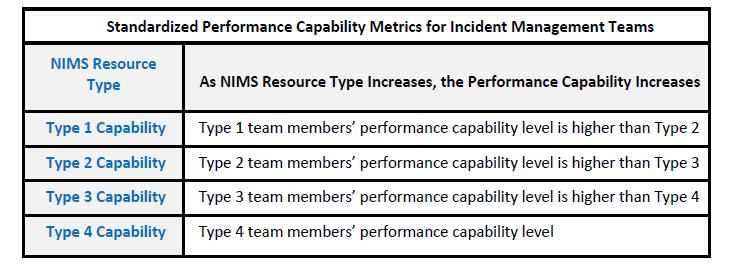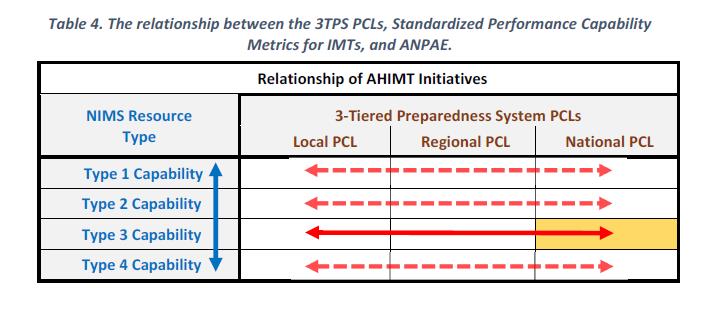Approved by Stakeholders on September 29, 2022
Implementation Scheduled for June 1, 2024
Understanding Qualification versus Preparedness
There is an important difference between two concepts that should be understood prior to reading the 3-Tiered Team Preparedness System documentation; when discussing ICS qualified personnel and incident management teams, the concepts of Qualifications and Preparedness are separate and independent of each other.
Qualification
The term qualification refers to being determined as meeting the all the training and experience requirements for a particular ICS position. The level of capability of performance that should be expected of a qualified incident management team and/or ICS qualified personnel is usually referred to by the NIMS resource type they are given under the guidelines of the NIMS Resource Typing System. As the performance capability of a resource increases, the NIMS resource type increases to indicate the increased performance capability. The performance capability for AHIMTs and IMTs are used to determine and standardize the resource typing of a team at the Type 1, 2, 3, or 4 level.

Preparedness
Preparedness is different than qualifications. Consider the example of a snowboarder. One may be qualified to ride the most difficult terrain, often labeled “Double Black Diamond” runs that include sheer cliffs and drops. However, if they are dressed for cool and clear weather – wearing only light outer clothing and having no backpack of emergency supplies, no GPS, and no avalanche airbag, they are not prepared for anything but cool weather on easy terrain. It does not mean they are not qualified, it means they are not PREPARED – two different concepts. The reverse is also true, a person who is just learning to snowboard, even if they are equipped with the best GPS locator, two-way radio, adequate emergency gear in their backpack, and dressed for blizzard conditions, may be prepared, but they are not QUALIFIED to be on a Double Black Diamond run.
Table 4 highlights the relationship of the 3‑Tiered Team Preparedness Guidance and the Performance Capability by NIMS resource type and how the two concepts are different.

The BROWN text in the table represents the 3TTPS and shows how the Local, Regional, and National PCLs are not affected by other guidance, incident complexity levels, and the NIMS resource typing of the AHIMT. The PCLs measure a team’s preparedness and readiness to manage the environmental and infrastructure conditions they will face, not the team’s performance capability typing, or the incident’s NIMS Incident Complexity Type level.
The RED solid arrow indicates how the 3TPS is currently being implemented at the NIMS resource typing level for Type 3 AHIMTs.
The light RED dashed arrows indicate that AHIMTs and IMTs at other performance capability typing levels (Types 1, 2, and 4) are being encouraged to meet and adhere to the guidance to ensure they are prepared to fulfill and capable of fulfilling, their mission at their designated resource typing level, while operating under the expected environmental conditions and level of available infrastructure and logistical support.
The Blue text and arrow represent the Standardized Performance Capability Metrics for Incident Management Teams described in Section 3.1 and depict how that concept is related to the NIMS typing methodologies. In NIMS, the Performance Capability of an AHIMT increases as the NIMS resource type increases. As shown in Table 4, the NIMS resource typing performance capability does not increase as a team’s PCL changes from one PCL to another. As an example, the performance capability expected of a Type 3 AHIMT remains the same regardless of the PCL (Local, Regional, or National) the team holds.
The GOLD-colored rectangle indicates Type 3 AHIMTs at the PCL National level. The AHIMT’s National PCL is a result of the team completing all of the components within all categories of the National PCL and completing the ANPAE, All-Hazards Incident Management Team National–PCL Assessment Exercise.
Together, these guidance documents and initiatives provide a comprehensive and complementary system to ensure the level of preparedness and capability that incident management teams need to be successful, and to enable jurisdictions to request the most appropriate incident management resource.
This concept paper was approved by stakeholders on September 29, 2022. A phased implementation and management plan was developed and approved, and implementation is scheduled for June 1, 2024. The concept paper includes the research and background information used to develop the system.